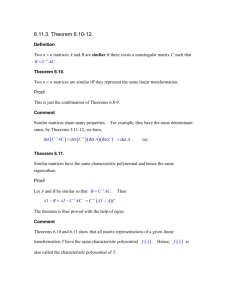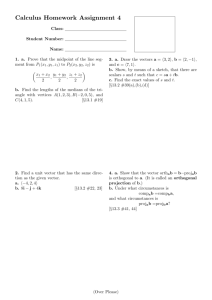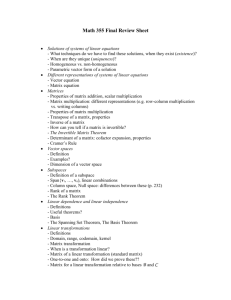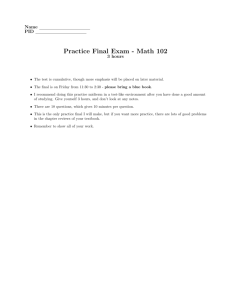Chapter 1 Vector
advertisement
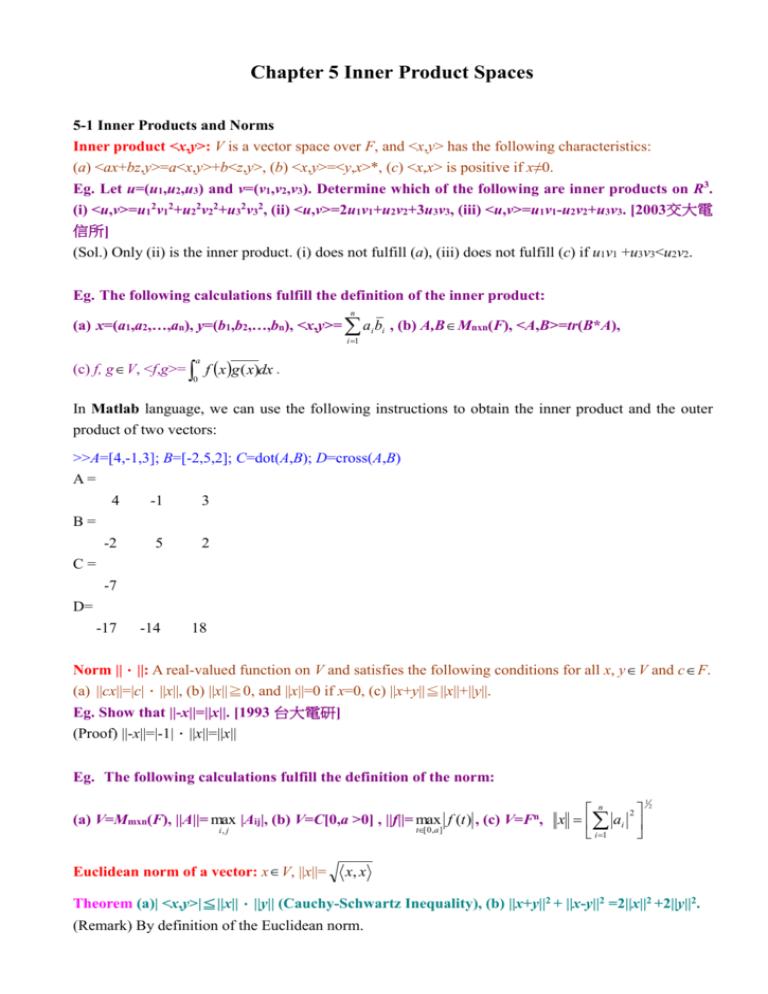
Chapter 5 Inner Product Spaces
5-1 Inner Products and Norms
Inner product <x,y>: V is a vector space over F, and <x,y> has the following characteristics:
(a) <ax+bz,y>=a<x,y>+b<z,y>, (b) <x,y>=<y,x>*, (c) <x,x> is positive if x≠0.
Eg. Let u=(u1,u2,u3) and v=(v1,v2,v3). Determine which of the following are inner products on R3.
(i) <u,v>=u12v12+u22v22+u32v32, (ii) <u,v>=2u1v1+u2v2+3u3v3, (iii) <u,v>=u1v1-u2v2+u3v3. [2003交大電
信所]
(Sol.) Only (ii) is the inner product. (i) does not fulfill (a), (iii) does not fulfill (c) if u1v1 +u3v3<u2v2.
Eg. The following calculations fulfill the definition of the inner product:
n
(a) x=(a1,a2,…,an), y=(b1,b2,…,bn), <x,y>= ai bi , (b) A,B Mnxn(F), <A,B>=tr(B*A),
i 1
(c) f, g V, <f,g>= f x g ( x)dx .
a
0
In Matlab language, we can use the following instructions to obtain the inner product and the outer
product of two vectors:
>>A=[4,-1,3]; B=[-2,5,2]; C=dot(A,B); D=cross(A,B)
A=
4
-1
3
B=
-2
5
2
-14
18
C=
-7
D=
-17
Norm ||.||: A real-valued function on V and satisfies the following conditions for all x, y V and c F.
(a) ||cx||=|c|.||x||, (b) ||x||≧0, and ||x||=0 if x=0, (c) ||x+y||≦||x||+||y||.
Eg. Show that ||-x||=||x||. [1993 台大電研]
(Proof) ||-x||=|-1|.||x||=||x||
Eg. The following calculations fulfill the definition of the norm:
(a) V=Mmxn(F), ||A||= max |Aij|, (b) V=C[0,a >0] , ||f||= max f (t ) , (c)
t[ 0 ,a ]
i, j
Euclidean norm of a vector: x V, ||x||=
V=Fn,
n
2
x a i
i 1
1
2
x, x
Theorem (a)| <x,y>|≦||x||.||y|| (Cauchy-Schwartz Inequality), (b) ||x+y||2 + ||x-y||2 =2||x||2 +2||y||2.
(Remark) By definition of the Euclidean norm.
In Matlab language, we can use the following instructions to obtain the Euclidean norm of a vector:
>> x=[3 4 5]; c=norm(x)
c=
7.0711
Orthogonal vectors x and y: x⊥y <x,y>=0.
Orthonormal vectors x and y: ||x||=||y||=1 and <x,y>=0 if x≠y.
Eg. Show that if {v1, v2, v3, …, vn} is an orthogonal set of non-zero vectors in an inner product
space, then v1, v2, v3, …, and vn are linearly independent. [2015 中央電研固態組、生醫電子組]
(Proof) Let y=
be a linear combination of v1, v2, v3, …, and vn.
Since {v1, v2, v3, …, vn} is an orthogonal set of non-zero vectors in an inner product space, we have <
vi, vj>=0 if j≠i but < vi, vi>≠0 in case of j=i.
Consider an inner product <y,vj>=<
, vj >=
< vi, vj >=ai< vi, vi>
Set y=0 and then we have ai=0 because < vi, vi>≠0 for each i. It implies that v1, v2, v3, …, and vn are
linearly independent.
m
Theorem V is an inner product space and S={x1,…, xm}. If y= a i xi , and then (a) aj=<y,xj>/<xj,xj>
i 1
for all j if S is orthogonal, and (b) aj=<y,xj> for all j if S is orthonormal.
m
m
y, x j
i 1
i 1
xj, xj
(Proof) (a) y , x j ai xi , x j ai xi , x j a j x j , x j a j
Eg. (8,-7)=8(1,0)-7(0,1) where 8=<(8,-7),(1,0)> and -7=<(8,-7),(0,1)>
Theorem A linear operator T: V→W, let β={x1,…,xm} and orthogonal set β’={y1,…,ym} are the bases
T ( x j ), y i
of V and W, respectively. Then the ij-entry Tij=
. If β’ is an orthonormal basis, then
yi , yi
Tij= T ( x j ), y i .
m
m
m
k 1
k 1
k 1
(Proof) ∵ T ( x j ) Tkj y k , ∴ T ( x j ), y i Tkj y k , y i Tkj y k , y i Tij y i , y i
Tij
T ( x j ), y i
yi , yi
Eg. For a linear operator T(a1,a2)=(a1-a2,a1,2a1+a2), let β={(1,2),(2,3)} be a basis for R2, and
β’={(1,0,0),(0,1,0),(0,0,1)} be an
orthonormal
basis
for R3, then we have
T(1,2)=(-1,1,4)=-1(1,0,0)+1(0,1,0)+4(0,0,1) and T(2,3)=(-1,2,7)=-1(1,0,0)+2(0,1,0)+7(0,0,1)
T
'
1
1
4
1
2
7
,
where
T11=-1=<T(1,2),(1,0,0)>,
T21=1=<T(1,2),(0,1,0)>,
T31=4=<T(1,2),(0,0,1)>, T12=-1<T(2,3),(1,0,0>, T22=2=<T(2,3),(0,1,0)>, and T32=7=<T(2,3),(0,0,1)>
5-2 Gram-Schmidt Orthogonalization Process
Gram-Schmidt Orthogonalization Process: Let S={y1,y2,y3,…,yn} be a linearly independent subset
y 2 , x1
of V and S’={x1,x2,x3,…,xn} be an orthogonal subset of V. Set x1=y1, x2= y2 x1 , x3=
x1 , x1
y3-
k 1 y , x
y3 , x1
y3 , x2
k
j
x j . Then Span(S)=Span(S’).
x1 x2 , …, and xk=yk-
x1 , x1
x2 , x2
j 1 x j , x j
Eg. For V=R3, β={(1,1,0),(2,0,1),(2,2,1)}, find an orthogonal basis for V by the Gram-Schmidt
orthogonalization process. [2007 台科大電研]
(Sol.) Let x1 (1,1,0), x2 (2,0,1)
x3 (2,2,1)
(2,0,1), (1,1,0)
(1,1,0) (2,0,1) 22 (1,1,0) (1,1,1)
(1,1,0), (1,1,0)
(2,2,1), (1,1,0)
(2,2,1), (1,1,1)
(1,1,0)
(1,1,1) ( 13 , 13 , 23 ) .
(1,1,0), (1,1,0)
(1,1,1), (1,1,1)
Then β’={x1,x2,x3} is an orthogonal basis.
Eg. Let the vector space P2 have the inner product <p,q>=
1
1
p( x)q( x)dx . Apply the
Gram-Schmidt process to transform the standard basis S={1,x,x2} into an orthonormal basis.
[2005 北科大電腦通訊所]
1
y 2 , x1
x 1dx 1 =x-0=x,
(Sol.) S={1,x,x2}={ y1, y2, y3}. Let x1= y1=1, x2= y2 x1 =x- 11
x1 , x1
1 1dx
1
1
1
x 2 1dx
x 2 xdx
y3 , x1
y3 , x2
1
1
1
1
x3= y3 x1 x2 =x2- 1
1 - 1
x =x2- -0= x2- .
3
3
x1 , x1
x2 , x2
1 1dx
x xdx
1
1
1
45 2 1
1
3
∴ Orthogonal basis: {1,x,x2- } Orthonormal basis: {
,
x,
(x - )}
3
3
8
2 2
Sperp: S⊥={x V: <x,y>=0 for all y S} is an orthogonal set of S.
Eg. For V=C3, S=Span{(1,0,i),(1,2,1)}, compute S⊥.
(Sol.) Suppose S⊥=Span{(a,b,c)},
a, b, c , 1,0, i 0 a ci
1 i
⊥
a, b, c , 1,2,1 0 b 1 i c , S = Span{( i, 2 ,1)}
2
Eg. Show that (a) {x1,x2,…,xk} is an ordered basis for W (subspace of V) and {x1,x2,…,xk,xk+1,…,xn}
is an ordered basis V, then {xk+1,…,xn} is an order basis of for W⊥.
(b) W is a subspace of V, then dim(V)=dim(W)+dim(W⊥). [台大電研]
n
(Proof) (a) x V x x, xi xi
i 1
If x W , then x, xi 0 for 1 i k . Therefore, x
n
x, x
i k 1
(b) According to (a), dim( V )=n=k+(n-k)=dim( W )+dim( W )
i
xi Spanx k 1 , , x n
Eg. Show that (a) W1 W2 W1 W2
and (b) W1 W2 W1 W2 . [1990, 1999 台大電
研]
(Proof) W1 W2 W1 W2 W1 W1 W2 W2 V
W1 and W2 W1 W2 , W1 W2 W1 and W2 W1 W2 W1 W2
x W1 W2 , then y W1 and z W2 y , x z, x 0
cy dz W1 W2 , cy dz, x c y, x d z, x 0
x W1 W2 W1 W2 (W1 W2 ) , ∴ W1 W2 W1 W2
On the other hand, U 1 U 2 U 1 U 2 U 1 U 2 U 1 U 2
Set U 1 W1 , U 2 W2 W1 W2 W1 W2
5-3 Various Matrices
Adjoint matrix: A* is the complex conjugate transpose of A. Note: A*≠adj(A) and (AB)*=B*A*.
1 i 2
1 i 3i
Eg. For A=
, then A*=
.
4
3i 4
2
Eg. For T: C2→C2 by T(a1,a2)=(2ia1+3a2,a1-a2), if β is the standard ordered basis, find T*(a1,a2).
[1998 台大電研]
(Sol.) T 1,0 2i,1 2i (1,0) 1 (0,1) and T 0,1 3,1 3 (1,0) (1) (0,1)
2i 3
2i 1
T
T*
, ∴ T*(a1,a2)=( -2ia1+a2,3a1-a2).
1 1
3 1
Theorem For A Mm×n(F), x Fn, y Fm, then <Ax,y>=<x,A*y>.
(Note: T x , y x, T * y for x, y V , T : V V )
Eg.
1 1 x u
x y u
x 1 2i u
x u 2iv
2i 3 y , v 2ix 3 y , v xu yu 2ixv 3 yv y , 1 3 v y , u 3v
Theorem (a) A Mm×n(F), Rank(A*A)=Rank(A). (b) A Mm×n(F), if Rank(A)=n, then A*A is
invertible.
(Proof) (a) A*Ax=0 Ax=0
1. " ": Ax 0 implies A* Ax 0
2. "": 0 A* Ax, x
n
Ax, A** x
m
Ax, Ax m , ∴ Ax=0
(b) A M mn F A* A M nn F
Rank(A*A)=Rank(A)=n, ∴ A*A is invertible
Orthogonal matrix A: AAt=AtA=I. Unitary matrix A:. AA*=A*A=I.
1 / 2
Eg. A=
1 / 2
1/ 2 t 1/ 2 1/ 2
t
t
, A =
, AA =A A=I, ∴ A is orthogonal.
1/ 2
1
/
2
1
/
2
i / 2
Eg. A=
i / 2
i / 2
i / 2
, A*=
i/ 2
i/ 2
i / 2
, AA*=A*A=I, ∴ A is unitary.
i / 2
Normal Matrix A: AA*=A*A.
i i
i i
Eg. A=
, A*=
, AA*=A*A, ∴ A is normal.
i i
i i
Eg. T is a normal operator on V. Show that (a) ||T(x)||= ||T*(x)||, (b) T(x)=λx T * x x , (c) λ1
and λ2 are distinct eigenvalues of T with corresponding eigenvector x1 and x2. Then x1 and x2 are
orthogonal. [2012 台大電研]
(Proof) (a) T x T x , T x T *T x , x TT * x , x T * x , T * x T * x
2
2
(b) Suppose T x x for some x V . Let U T I ,
0 U x U * x (T * I )x , ∴ T * x x .
(c) Let T x1 1 x1 , T x2 2 x2 ,
1 x1 , x2 1 x1 , x2 T x1 , x2 x1 , T * x2 x1 , 2 x2 2 x1 , x2
1 2 , x1 , x2 0 .
Self-adjoint (Hermitian) matrix A: A=A*.
2 5i
1
Eg.
is a self-adjoint matrix.
2 5i 3
(Note: A self-adjoint matrix is also a normal matrix, but a normal matrix may not be self-adjoint)
Theorem If A is a self-adjoint matrix, all eigenvalues of A are real. [2000 台大電研]
(Proof) x Ax A* x x for some x≠0, λ is real.
Gramian matrix A: B Mm×n(F) such that A=BBt then A is called the Gramian matrix.
A is symmetric.
Theorem A is a Gramian matrix
all eigenvalues of A are nonnegative.
(Proof) (1) At=(BBt)t=BBt=A, ∴ A is symmetric. (2) For some x 0, and Ax=λx,
then
Ax, x x, x x, x BB t x, x B t x, B t x 0, x, x 0, 0
Eg. Which of the following matrices is Hermitian? Which is normal?
i
2 i
1
B 2
A
2 i 1
1
2
1
i
1
3 1 i i
0
2 C i
0
2 i D 1 i 1 3 [交大電子所]
i
i
1 2 i
3 1
0
2
(Sol.) A=A* and D=D*, ∴ A and D are both Hermitian matrices,
1 i
1 i
CC*=C*C, BB*=
, B*B=
, ∴ C is normal but B is not normal.
i 1
i 1
5-4 Special Characteristics of Matrices
Ax, x >0 for all x≠0, then A is positive definite.
Positive definite: If
Eg. If A is a positive-definite matrix, then all the eigenvalues of A are positive.
(Proof) For some x≠0 and Ax=λx, positive definite:
Ax, x x, x x, x 0 0 .
Eg. Let A be a complex normal (or real symmetric) n×n matrix with eigenvalues: λ1, λ2, …, λn,
n
n
i 1
i 1
2
n
and then show that (a) tr(A)= i and tr(A*A)= i , (b) det(A)= i . [1998 台大電研]
i 1
n
(Proof) Let A=QDQ-1 and D be diagonal, tr(A)=tr(QDQ-1)=tr(DQQ-1)=tr(D)= i
i 1
n
det A det QDQ 1 det Q det D det Q 1 det Q det D det Q 1 det D i .
i 1
2
1
Eg. Let λi be the eigenvalues of A=
- 1
0
1 -1 0
3 4 2
, 1≦i≦4, (a)
4 1 2
2 21
4
i
i 1
? (b)
4
i
?
i 1
( c ) I s A p o s i t i v e definite? [台大機研]
4
(So1.) ∵ A is a real symmetric matrix, ∴ (a)
i tr(A) = 2+3+1+1=7, (b)
i 1
4
=det(A) = 10,
i
i 1
(c) Method 1: λ<0 A is not positive definite.
2 1 -1
2 1
Method 2: det([2])=2>0 and det(
)=5>0, but det( 1 3 4 )=-38<0 Not positive definite.
1
3
- 1 4 1
A is unitarily equivalent to B: P fulfills B=P*AP and P-1=P*.
Theorem (a) A is complex normal A is unitary equivalent to a diagonal matrix. (b) A is real
symmetric A is orthogonally equivalent to a real diagonal matrix.
(Proof) AA* PDP * PDP *
*
PDP * PD * P * PDD * P *
A PDP * , A* A PDP * PDP * PD * DP * . DD * D * D, A* A AA*
*
Projection: V=W1⊕W2, x1 W1, and x2 W2, x=x1+x2. If T(x)=x1, then T is projection on W1. That is,
R(T)=W1={x: T(x)=x} and N(T)= W2. (Note: T2=T if T is a projection.)
Orthogonal Projection: If R(T)⊥=N(T) and N(T)⊥= R(T) for T: V→V be a projection.
Theorem T is a linear operator on V. Then T is an orthogonal projection. T2=T=T*.
Eg. Let T: R2→R2 be a linear operator. For any z R2, T(z)=p, where p is the projection of z on the
line x=y. Find [T]. [交大電信所]
1
2 } and the standard basis of R2 is { 1 , 0 }.
(Sol.) The orthonormal basis of line x=y is {
0 1
1
2
1
1
2 >= 1 , so the orthogonal projection of 1 onto the line x=y is
Inner product: < ,
0
2
0 1
2
1 1
1
2 = 2 = 1
1
1 2
2
2 2
Inner
1
2
1 1
0 + 2
0
1
1
0
2 >= 1 , so the orthogonal projection of 0 onto the line x=y is
product: < ,
1
2
1 1
2
1 1
1
1
2 = 2 = 1 1 + 1 0 , ∴ [T]= 2
2 , and we have [T]2=[T]=[T]*
1
1
1 1 2 0 2 1
2
2
2 2
1
0 0
Eg. Find the orthogonal projection of the vector v= 0 onto the subspace S=Span( 1 , 1 ).
2
1 1
[交大電子所]
0 0
0 0
(Sol.) Transform the orthogonal basis { 1 , 1 } into the orthonormal one: { 1 , 1 }.
2
2
1
1
1 1
2
2
1
< 0
2
0
1
0
1
,
>=-√2, so the orthogonal projection of the vector v= 0
onto 1 is
2
1
2
1
2
0 0
-√2 1 = 1 .
2
1
1
2
1 0
1
0
1
< 0 ,
>=-√2, so the orthogonal projection of the vector v= 0
onto 1 is
2
2 1
2
1
2
0 0
-√2 1 = 1 .
2
1 1
2
0
0 1 0 0 1
1
1 1 0 0
1
1
∵ 0 -(-√2
)-(-√2
)= 0 - 1 - 1 = 0 , ∴ v= 0 = 0 + 1 + 1
2
2
1
1 2 1 1 0
2
2 0 1 1
2
2
1
0 0
and { 0 }⊥S=Span( 1 , 1 )
0
1 1
Rotation: orthogonal basis β={x1,x2} for W, and θ is real and fulfills T(x1)=x1cosθ+x2sinθ,
T(x2)=-x1sinθ+x2cosθ, and T(y)=y, y W⊥, where W is a 2-dimensional subspace. And then T is a
⊥
⊥
rotation of W about W , where W is the axis of rotation.
Reflection: T(x)=-x, x W and T(y)=y, y W⊥. And then T is a reflection of W about W⊥, where
W is a 1-dimensional subspace.
Eg. T: R2→R2 by T(a,b) = (-a,b). Let W=Span({e1}) and W⊥=Span({e2}). It is reflection of R2 about
W⊥ (the y-axis).
Theorem T is an orthogonal operator on a 2-dimensional real inner product space. If det(T)=1,
then T is a rotation. If det(T)=-1, then T is a reflection.
cos sin
(Proof) By definition, T
is a rotation, ∴ det(T) = 1.
sin cos
Choose z1 , z 2 ,... be an orthogonal basis for V and z1 W,
T
1 0 0
0 1
det(T) = -1.
0
0 0 1
Theorem The composition of a reflection and a rotation is a reflection.
(Proof) det(T1T2)=det(T1)det(T2)= -1
normal on V over F C
Spectral Theorem If T is
, and λ1, …, λk are distinct eigenvalues of
self - adjoint on V over F R
T. Let Wi be the eigenspace of T corresponding to λi, and Ti be an orthogonal projection on Wi.
(Ti(x)=xi Wi). Then (a) V=W1⊕W2⊕W3…⊕Wk, (b) Wi⊥= W j (direct sum), (c) TiTj=δijTi, (d)
ji
I=T1+T2+…+Tk, (e) T=λ1T1+λ2T2+…+λkTk.
0, i j
(Proof) (c) Let x 0 and T j ( x) x j , then Ti Tj ( x) Ti ( x j )
i j Ti ( x) TiT j i j Ti
xi , i j
(d) x Ix x1 ... xk T1 ( x) T2 ( x) ... Tk ( x) (T1 T2 ... Tk )( x) , ∴ I T1 T2 ... Tk .
(e) For x V , then x x1 ... xk , where xi Wi ,
T ( x) T ( x1 ) ... T ( xk ) 1 x1 ... k xk 1T1 ( x) ... k Tk ( x) (1T1 ... k Tk )( x) ,
∴ T 1T1 ... k Tk
Theorem (a) F=C, T is a unitary operator T* is normal and |λ|=1 for all eigenvalues. (b)
T=-T* each λ is pure imaginary. (c) T is a projection each λ is either 0 or 1.
5-5 Bilinear Forms
Bilinear form, H: If (a) H(ax1+bx2,y)=aH(x1,y)+bH(x2,y) and (b) H(x,ay1+by2)=aH(x,y1)+bH(x,y2) for
x1, y1, x2, y2, x, y V, a, b F.
Theorem For each H B(Fn), ! A Mn×n(F) fulfills H(x,y)=xtAy for all x, y Fn.
a b
a b
Eg. Define H : R 2 R 2 R by H ( 1 , 1 ) 2a1b1 3a1b2 4a 2 b1 a 2 b2 for all 1 , 1 R 2 ,
a2 b2
a2 b2
a1
b1
2 3
t
then let x , y , A
H ( x, y ) x Ay [a1 a 2 ]
a
b
4
1
2
2
2 3
4 1
Symmetric bilinear form: H(x,y)=H(y,x) for all x, y V.
Quadratic form: K: V→F if H B(V) fulfills K(x)=H(x,x)=xtAx.
Eg. Let f(t1,t2,t3)= 2t1 t 2
2
f (t1 , t 2 , t 3 ) t1 t 2
2
t3
0
2 3
t1
6t1t 2 4t 2 t 3 K ( t 2 ) , and then A= 3 1 2
t 3
0 2 0
0 t 1
2 3
3 1 2 t is a quadratic form.
2
0 2 0 t 3
b1
b .
2
Eg. There are two bases (x1,y1) and (x2,y2) in R2. If the equations of the same ellipse represented
by two distinct bases are described as follows, respectively: 2x12-4x1y1+5y12-36=0 and
x22+6y22-36=0. Please find the transformation matrix between these two bases. [2004 台大電研]
x
2
(Sol.) Let K 1 2 x1 2 5 y1 2 4 x1 y1 , A
2
y1
2 a1
a
2
0 1 a , a 0,
4 a2
1
a2
a
1
2
b
4 2 b
1 1 A 1I 1
a
2
2 2
2
, det
2 5 1 6, 1, 6
5
b
1
2 6 A 2 I 1
1 0 1 b , b 0
2
b2 2 1 b2
b2
Q
2
5
1
5
x
∴ 1
y
1
1
5 fulfills Q 1 AQ Q t AQ 1 0 for 1 2, 1 1 .
0 6
2
5 1 5 2
5
2
5
1
5
1
5 x 2 K x2 x 2 6y 2 2 x1 2 4 x1 y1 5 y1 2 36 0 x 2 2 6 y 2 2 36 0
2
2
y
2 y 2
2
5
Eg. [t1,t2,t3]t R3, 3t12+3t22+3t32-2t1t3+2√2 (t1+t3)+1=0. Find a basis β for R3 such that the above
equation is simplified.
t1
3 0 1
2
2
2
(Sol.) Let K t 2 3t1 3t 2 3t 3 2t1t 3 , then A 0 3 0 . It is found that an orthogonal
t 3
1 0 3
0
matrix Q 1
0
1
0
3 0 0
1
1
2
1 1
t
0 fulfills Q AQ 0 4 0 for 1 ,
0 ,
0 .
2 2
1
0
0 0 2
1
1
2
1
2
0
1
2
t1 0
∴ t 2 1
t 3 0
1
2
0
1
2
1
2 s1
0 s 2 K ( x) 3s12 4s2 2 2s3 2
1
s3
2
3t1 3t 2 3t 3 2t1t3 2 2 (t1 t 3 ) 1 0 3s1 4s2 2s3 4s3 1 0 .
2
2
2
2
2
2
